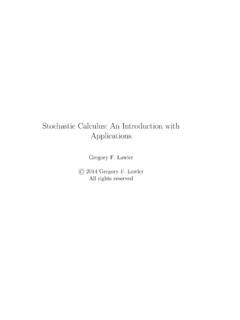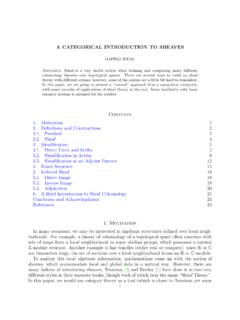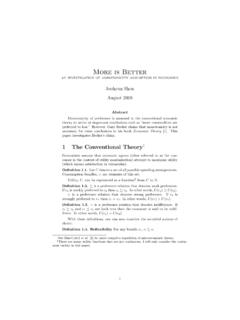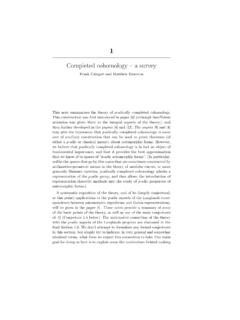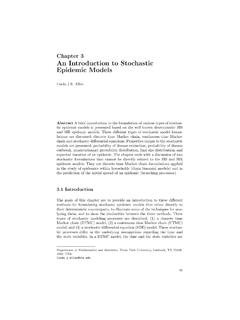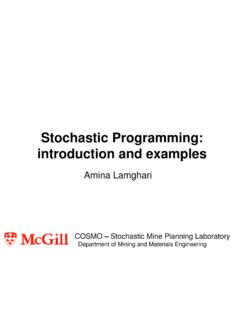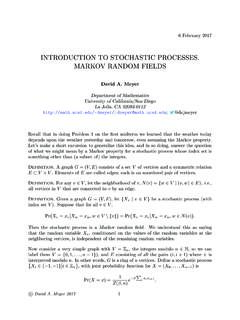Transcription of Introduction de la spculation Preliminaries
1 AN Introduction TO THE stochastic INTEGRALMATT paper gives an elementary Introduction to the developmentof the stochastic integral. I aim to provide some of the foundations for some-one who wants to begin the study of stochastic calculus, which is of greatimportance in the theory of options calculus is now one of the central tools in modern Mathematical Fi-nance. Its beginnings can be traced back to L. Bachelier s 1990 dissertationThoriede la spculationin which he modeled stock prices with Brownian motion. Nearlyone hundred years later Robert Miller and Myron Scholes won the Nobel Prizeusing stochastic calculus and arbitrage pricing to derive the famed Black-Scholesequation. In this paper I will provide a hopefully gentle Introduction to stochasticcalculus via the development of the stochastic have found that in the literature there is a great divide between those introduc-tory texts which are only accessible to PhD s on the one hand, and those which lackrigor altogether and are directed towards traders.
2 Armed with some basic analysisand probability this presentation should be accessible at the undergraduate motionon [0,1] is a stochastic process{Bt: 0 t 1}on some probability space ( ,F,P) adapted to{Ft}with thefollowing properties:(i)B0= 0(ii) The random variableBt Bsis independent ofFsfor anys t.(iii) For any 0 s t 1Bt Bsis normally distributed with mean 0 andvariancet s.(iv) With probability 1Bt( ) is a continuous function of filtration{Ft}t 0is a family of sub-sigma algebras of some sigma-algebraFwith the property that ifs < tthenFs Ft. Saying a process{Xt: 0 t < }is adapted to{Ft}t 0means that for any process{Xt: 0 t < }adapted to the filtration{Ft}t 0is amartingaleif the following conditions hold:(i)E[|Xt|]< for all 0 t < (ii)E[Xt|Fs] =Xsfor all 0 s t < 12 MATT equivalent assertion to Property (iii) is that for any0 t1 tn 1 the random variablesBt1,Bt2 Bt1.
3 ,Btn Btn 1are Brownian motion{Bt}is a martingale with respect to 0 s t 1. We can decompose the conditional expectation intoE[Bt|Fs] =E[Bt Bs|Fs] +E[Bs|Fs].By Property (ii) of Brownian motionBt Bsis independent ofFssoE[Bt Bs|Fs] =E[Bt Bs] = 0. Also,BsisFsmeasurable soE[Bs|Fs] = these results we haveE[Bt|Fs] =Bs. Later on we will need to use the following result which we will prove in Propo-sition :lim P 0n i=1(Bti Bti 1)2=TwhereP={t0,..,tn}is any partition of [0,T] and the convergence is inL2( ).This limit is called thequadratic variationof the Brownian motion and is onemeasure of its volatility. Most functions we see in ordinary calculus have zeroquadratic variation, and in fact it is not hard to see that any function with acontinuous derivative has zero quadratic quadratic variation ofBtover[0,T]is a partitionP={t0.}
4 ,tn}. To simplify notation define a newvariableXi=Bti Bti 1. Recall that by Property (ii) of Brownian motionXi=Bti Bti 1follows a normal distribution with mean 0 and variance (ti ti 1), sothatE[X2i] = (ti ti 1). Therefore,E[n i=1X2i] =n i=1E[X2i] =n i=1(ti ti 1) =T.( )With a little work one can show thatE[X4i] = 2(ti ti 1)2, which in turn impliesthatV ar[X2i] =E[(X2i)2] (E[X2i])2= (ti ti 1)2. Now, using the independenceof theXi,E[(n i=1X2i T)2] =V ar[n i=1X2i] =n i=1V ar[X2i] =n i=1(ti ti 1)2 T P ( )If we choose partitions such that P 0 thenE[( ni=1X2i T)2] converges to0. AN Introduction TO THE stochastic Integral for Simple we model the price of an asset as a Brownian motionwith valueBtat time t1. Suppose we are allowed to trade our asset only at thefollowing times: 0 =t0< t1< < tn= 1.
5 At timetkwe can choose to holdXkshares of our asset, and we must hold these shares up until the next time periodtk+1. Note that in making the decision to holdXkshares we are only allowed to useinformation up to that time - we cannot predict future price movements. The changein the value of our portfolio between timetk 1and timetkisXk 1(Btk Btk 1),which is simply the change in price multiplied by the number of shares we instance, if at the beginning of the period we are holding 5 shares for $5 a piecebut by the end of the period the shares are worth $7 a piece, over that interval wehave made $10. It is clear then that the change in our wealth over the time period[0,1] is given by:n i=1Xi 1(Bti Bti 1)It is our ultimate goal to consider this quantity as we allow for trading in con-tinuous time, we can buy or sell an asset at anyt [0,1].
6 Processf(t, ) is a stochastic process of the formf(t, ) = ni=1 i 1( )1[ti 1,ti)(t) where 0 =t0< t1< < tn= 1 is a partitionof [0,1] and i 1( ) is aFti 1measurable random , a simple process can be thought of as a step function on [0,1] witheach step taking on a random value. A simple process is analogous to the tradingsituation above where we chose certain amounts of stocks to hold over a timeinterval, where one s decision was based solely on past the partition 0 =t0< t1< < tn= 1 letS(t0,..,tn)denote the class of simple stochastic processes adapted to{Ft}with the additionalrequirement that iff(t, ) S(t0,..,tn) then f 2[0,1] < .3 Finally, we letS= S(t0,..,tn), the union taken over all partitions of [0,1].]
7 Definition integralforf(t, ) S, more specificallyf(t, ) S(t0,..,tn) , from 0 to T is T0fdB= k 1i=1 i 1(Bti Bti 1) + k(BT Btk) forT [tk,tk+1]. We also use the notation T0fdB=I(T, ,f).From the definition it is not hard to see thatI:S L2( ) is linear, (t, ,af+bg) =aI(t, ,f) +bI(t, ,g) fora,b R. The following proposition isof crucial importance to the extension of the integral to a wider class of (t, ) Swe have I(t, ,f) 2 = f 2[0,t] . In otherwords,I:S L2( )is an isometric speaking a Brownian motion is not an appropriate model for an asset price such as astock which takes only non-negative values. Generally one considers a geometric Brownian motion- however our example does provide the necessary motivation for better developed models2 From now on we will suppress the argument in i 1( ).
8 3We take f 2[0,1] = 10E[f2(t, )]dt, whereE[f(t, )] is the order to make life easier, but with no loss of generality, we taket=tkso that t coincides with some partition point. DefineXi=Bti Bti 1. NowI2(t, ,f) = ki=1 2i 1X2i+ i6=j i 1 j 1 XiXj. One can argue that from theintegrability condition onf(t, ) and the Cauchy-Schwartz inequality the expec-tations of both these sums exist. To that end we considerE[ i 1 j 1 XiXj] fori < j. Since fori < j i 1 j 1 XiisFj 1measurable,E[ i 1 j 1 XiXj] =E[E[ i 1 j 1 XiXj|Fj 1] =E[ i 1 j 1 XiE[Xj|Fj 1]] . But because by Property(iii) of Brownian motion,Xjis independent ofFj 1, soE[Xj|Fj 1] =E[Xj] = 0andE[ i 1 j 1 XiXj] = 0. Thus we have:( )E[ i6=j i 1 j 1 XiXj] = 0 Furthermore,E[ 2i 1X2i] =E[ 2i 1]E[X2i] =E[ 2i 1](ti ti 1) and( )k i=1E[ 2i 1X2i] =k i=1E[ 2i 1](ti ti 1) = f 2[0,t] so that combining and I(t, ,f) 2 E[I2(t, ,f)] = ki=1E[ 2i 1X2i] = f 2[0,t] Proposition (t, ) S, thenI(t, ,f)is a martingale with respect to the{Ft} (t, ) Sthere is a partition 0 =t0< t1< < tn= 1 suchthatf(t, ) = ni=1 i 1( )1[ti 1,ti)(t).]]
9 Take 0 s t 1. Either s and t arein the same partition interval, or they are in different intervals - we consider themore difficult case when they are in different intervals. Assumetk s tk+1andtl t tl+1withk < l. Simply by the linearity of conditional expectationE[I(t, ,f)|Fs] =E[k i=1 i 1(Bti Bti 1)|Fs] +E[ k(Btk+1 Btk)|Fs]+E[l i=k+2 i 1(Bti Bti 1)|Fs] +E[ l(Bt Btl)|Fs].( )Consider the second term on the RHS of ( ):E[ k(Btk+1 Btk)|Fs] =E[ kBtk+1|Fs] E[ kBtk|Fs]= kE[Btk+1|Fs] kE[Btk|Fs]= k(Bts Btk)( )The last step follows from the martingale property of Brownian motion. Now welook at the fourth term on the RHS of ( ), keeping in mind the Tower Propertyof conditional expectation:AN Introduction TO THE stochastic INTEGRAL5E[ l(Bt Btl)|Fs] =E[E[ l(Bt Btl)|Fl]|Fs]=E[ lE[(Bt Btl)]|Fs]= 0( )By similar types of arguments we can showE[k i=1 i 1(Bti Bti 1)|Fs] =k i=1 i 1(Bti Bti 1)( )E[l i=k+2 i 1(Bti Bti 1)|Fs] = 0( )Together ( )-( ) implyE[I(t, ,f)|Fs] =I(s, ,f).
10 Example step function (in the usual sense from analysis) is a specialtype of simple stochastic process - we can think of the steps as random buttaking certain constant values with probability one. For instance, letf(t) = ni=1 i 11[ti 1,ti)(t) where in this case each i 1can be thought of as a true con-stant. By definition 10fdB= ni=1 i 1(Bti Bti 1), which is a linear combi-nations of independent normal random variables. Since a linear combination ofindependent normal random variables is again a normally distributed random vari-able, it remains to compute the mean and variance to completely characterize thedistribution ofI(1, ,f).By Proposition (1, ,f) is a martingale, and consequently for anys,t [0,1],E[I(s, ,f)] =E[I(t, ,f)].]
